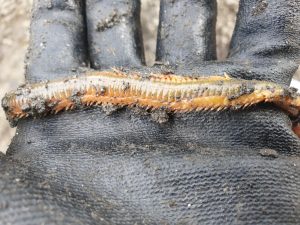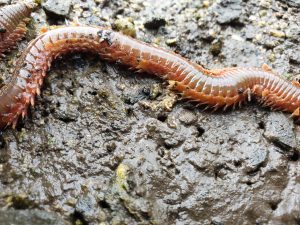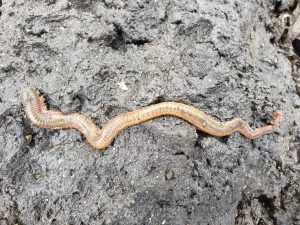KingSearch
Survey for King Ragworm

KingSearch is a citizen science project created to map populations of king ragworm (Alitta virens) around the Irish coast. King ragworm have vital roles in the marine ecosystem but details on where they are found and where their spawning grounds could be are very limited. We are asking every explorer, beach comber, dog walker, and bait digger out there, both young and old, to record any sightings (dead or alive) of this species so we can:
- Build a database full of your sightings.
- Learn more of the biology of this species and the ecology of the ecosystem in which they are found.
- Explore why they are found in some locations but not others.
- Explore potential biotechnology applications and the recovery of depleted populations.
- Encourage local stewardship of the habitat, where local people look after local resources.
- Inform policy on the management of this species and how we use the local ecosystem, so it is protected, enjoyed, and resources remain plentiful for future generations.
How to get involved
You can participate with the search in two ways:
Casual sighting
If you see a king ragworm swimming in the water column or washed up on the shore, you can make a record of what you find. This tells us that a population or spawning ground is nearby.
You will need: a camera or smartphone. Remember to make a mental note of your location or place a pin on google maps to get your lat/long.
Deliberate search
This involves looking under the sediment 1-2 hours before low tide to find a lost king ragworm population. This tells us that a population is present, an estimation of its size, and how healthy it is based on numbers present (abundance).
You will need: local tides (www.tidesnear.me) and the weather forecast, a fully charged smartphone, appropriate clothing including a pair of wellies or boots, a garden fork, and a pair of gloves.
You can make a note (draft a message on your phone) of the estimated search area (in metres), how many holes you dug, how many king ragworm you found per hole, and the type of sediment where you found them e.g., muddy sand, sandy gravel etc. Remember to make a mental note of your location or place a pin on google maps.
More information on how to identify a king ragworm and record the sighting can be found in our KingSearch Survey Guide.

Where to Search
King ragworm are usually found in the sediment of channels, at the mouth of estuaries where its most saline, and sometimes in sheltered bays and harbours.
They are an omnivorous species which feed on algae, deposits, and smaller invertebrates so they require an environment which brings nutrients with each passing tide, suppourting these other organisms. Look for areas where king ragworm are protected from the full force of the ocean but where food will be brought in by the tide. They cannot tolerate fluctuations in salinity (stenohaline) and so cannot survive in the upper reaches of an estuary.
They seem to prefer black muddy sand and gravel/shale which may be hidden just below the seabed. They are also known to be found near mussel and/or cockle beds.
Taking photos of king ragworm
- Ensure your camera is in focus. Try use the macro setting if applicable. Don’t use the flash unless it’s twilight/dark outside. Take several photos of the entire animal within the frame of the screen.
- Enlarge with your fingers and select the sharpest image. Remember detail is key for a positive identification. Proceed to next step once you have chosen the best image.
- Imagine the animal comes in three equal sections: a top, a middle, and an end. If possible, take several side-view photos of the middle section of the animal. What its parapodia (feet-like appendage) looks like will help in positive identification, especially for difficult ID’s so the closer and sharper the image, the better. See examples below.




- Be careful not to harm any animals you find. Once images have been taken, return them to where they were found. Back-fill and level any sediment you have dug to minimize disturbance of the habitat.
Uploading your results
Anything you find, let us know. Without your contribution, we can’t help to inform policy and protect this species. You can create a data point by submitting a record through our online recording form.
Even if you do not find anything, we would still love to hear about it, you can share your adventure with us on our Twitter and Instagram pages @kingsearchbio.
Safety
Before you head out on a search, take care of your own safety, it can be easy to find yourself in a dangerous position when on the shoreline.
- Check the weather forecast and the LOCAL tides. 1-2 hours before low tide is best for finding king ragworm but never let your path between you and dry land be cutoff by rising water. The tide will not rise evenly, and channels may fill up faster than you realise. Leave the beach before the tide starts to rise.
- Never go out in bad weather or during weather warnings.
- Tell someone where you are going and when your due back. Also, never go alone. Bring a buddy or go with a group.
- Bring a fully charged smartphone. If you get into difficulties, you can call 112 or 999 and ask for the coastguard.
- Dress appropriately for the weather and wear appropriate footwear e.g., wellies or boots. Be careful where you step. A walking stick or the garden fork is perfect for checking your footing ahead of you. An area might look like hard sand and turn out to be a hole filled with water. Similarly, keep away from deep water or drops.
- Do not enter mudflats as its super easy to become stuck. If you start to sink above your heel, re-trace your steps back to safety.
- Do not enter private property without the owner’s permission and keep away from restricted or protected areas.
- Do not interfere with mooring lines, anchors and other harbour structures. Disturbing the sediment around these objects could undermine their stability.
- Do not put yourself or others in danger. Keep away from sheer cliffs and loose rocks/sand and do not try to reach areas which are difficult to access.



